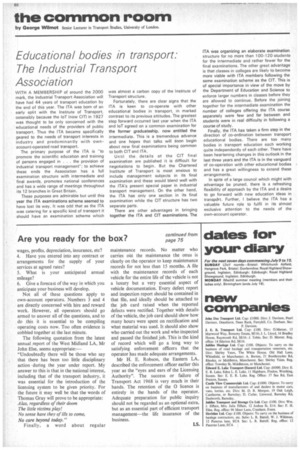Educational bodies in transport: The Industrial Transport Association
Page 88

If you've noticed an error in this article please click here to report it so we can fix it.
WITH A MEMBERSHIP of around the 2000 mark, the Industrial Transport Association will have had 44 years of transport education by the end of this year. The ITA was born of an early split with the Institute of Transport, ostensibly because the loT (now CIT) in 1927 was thought to be only concerned with the educational needs of the providers of public transport. Thus the ITA became specifically geared to the needs of transport interests in industry and predominantly with ownaccount-operated road transport.
The primary purpose of the ITA is to promote the scientific education and training of persons engaged in . . . the provision of industrial transport management"; to achieve these ends the Association has a full examination structure with intermediate and final awards, promotes national conferences and has a wide range of meetings throughout its 12 branches in Great Britain.
These purposes are admirable but until this year the ITA examinations scheme seemed to have lost its way. It was odd that as the ITA was catering for a specific kind of transport it should have an examination scheme which was almost a carbon copy of the Institute of Transport structure.
Fortunately, there are clear signs that the ITA is keen to co-operate with other educational bodies in transport, in marked contrast to its previous attitudes. The greatest step forward occurred last year when -the ITA and loT agreed on a common examination for the former graduateship, now entitled the intermediate. This is a tremendous advance and one hopes that talks will soon begin about new final examinations being common to both CIT and ITA.
Until the details of the CIT final examination are published it is difficult for negotiations to begin. But the Chartered Institute of Transport is most anxious to include management subjects in its final examination and these would blend well with the IA's present special paper in industrial transport management. On the other hand, the ITA has only one section in its final examination while the CIT structure has two separate parts.
There are other advantages in bringing together the ITA and CIT examinations. The ITA was organizing an elaborate examination structure for no more than 100-120 students. for the intermediate and rather fewer for the final examinations. The other great advantage is that classes in colleges are likely to become more viable with ITA mernbers following the same examination scheme as the CIT. This is of special importance in view of the move by the Department of Education and Science to enforce larger numbers in classes before they are allowed to continue. Before the joining together for the intermediate examination the number of colleges offering the ITA course separately were few and far between and students were in real difficulty in following a course of study.
Finally, the ITA has taken a firm step in the direction of co-ordination between transport educational bodies. There are too many bodies in transport education each working quite independently of each other. There have been heartening changes in this outlook in the last three years and the ITA is in the vanguard of co-operation with other educational bodies and has a great willingness to extend these arrangements.
In spite of a large council which might with advantage be pruned, there is a refreshing flexibility of approach by the ITA and a desire to go forward with new education ideas in transpdrt. Further, I believe the ITA has a valuable future role to fulfil in its almost exclusive attention to the needs of the own-account operator.












































































































































